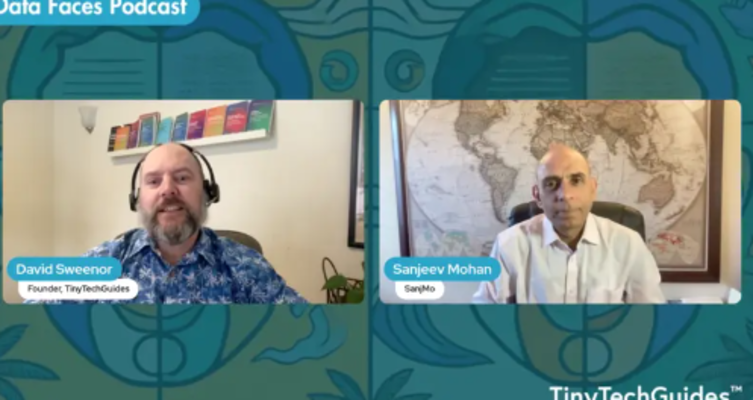
AI Agents: What Business Leaders Need to Know Now

Sanjeev Mohan explains why data quality trumps model size, how regulated industries have an unexpected edge, and what keeps AI agents from scaling
Listen now on YouTube | Spotify | Apple Podcasts
“Don’t start with the technology. Start with your business imperatives. Everything else follows from there.” – Sanjeev Mohan
About the Speaker
Sanjeev Mohan is Principal at SanjMo and former VP Research at Gartner. As a leading voice in data and AI strategy, he guided the data and AI practice at Gartner before launching his advisory firm. His recent attendance at Davos 2024 and deep expertise in enterprise technology make him uniquely qualified to discuss AI agents’ business impact.
The Business Case for AI Agents
The divide between AI agents and traditional AI comes down to action versus prediction. While a language model suggests what comes next, an agent makes decisions and executes them. This distinction shapes how organizations should approach implementation.
“It’s about understanding context from various sources, making reasoning, coming up with a plan of action and then executing it” – Sanjeev Mohan
At Davos 2024, Mohan observed a telling pattern. Business leaders couldn’t stop talking about AI agents, yet struggled to explain their implementation plans. This gap between interest and execution opens opportunities for organizations ready to move thoughtfully.
Success requires three elements: reliable decision-making capabilities, predictable costs at scale, and robust privacy controls. Early adopters find traction in areas where speed and scale outweigh perfect accuracy – research tasks, customer service, and data analysis.
Building Your AI Agent Foundation
Data quality, not model size, determines success with AI agents. Organizations chasing the latest models miss this fundamental truth.
“It’s one word: data. It’s the quality or the richness of the data you have, because no one can replicate that” – Sanjeev Mohan
Most enterprise data – about 80 percent – sits unused in emails, documents, and chat logs. This unstructured information holds the key to competitive advantage. The organizations that unlock it first gain an edge others can’t easily copy.
The Infrastructure Reality
The monitoring challenge looks different from traditional software development. AI agents operate probabilistically, requiring continuous evaluation rather than point-in-time testing.
“In AI applications, I have to constantly monitor because it can go off the rails, even with my best testing” – Sanjeev Mohan
Regulated industries, surprisingly, hold an advantage. Years of data organization for compliance means banks, healthcare providers, and financial services firms start ahead. They’ve built the foundation others now scramble to create.
Cost structures also shift. While large language models demand significant computing power, newer approaches focus on efficiency. “It’s not about how big your model is… it’s trained on relevant data,” Mohan points out. This changes the investment calculation for organizations.
Talent and Teams
Technical skills matter less than curiosity and adaptability. Mohan challenges conventional hiring wisdom: “I would look for curiosity because so much is getting disrupted. Having this flexibility to learn and not being afraid to experiment – that’s what matters.”
“You can teach skills. You can’t teach curiosity.” – Sanjeev Mohan
Organizations need people who question processes and experiment with new tools. The most successful teams combine domain expertise with technological adaptability. This mix helps navigate the balance between automation and human judgment.
Looking Ahead
Microsoft’s move to nuclear power for data centers signals a broader shift. Computing requirements will grow as agent usage increases. Infrastructure planning needs to account for this reality.
Risk management takes new forms. Traditional controls don’t map cleanly to autonomous systems. Organizations need clear operational boundaries, continuous feedback loops, and robust monitoring.
“Cut out noise… Just look at what are your business imperatives. How can AI improve that? That’s it.” – Sanjeev Mohan
The winners in this space won’t necessarily have the biggest models or the most agents. They’ll have the clearest use cases, the best data, and the strongest governance. Success comes from starting small, measuring carefully, and scaling what works.
Listen to the full conversation with Sanjeev Mohan on:
- Data Faces podcast: https://youtu.be/2fdMAsMQnP0?si=jG73MT5KQema5Ie2
- Follow Sanjeev on LinkedIn: https://www.linkedin.com/in/sanjmo/
- Read more on his blog: https://medium.com/@sanjmo

 - by
- by





